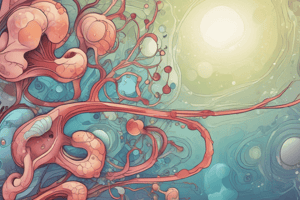Podcast
Questions and Answers
What is the hallmark of renal dysfunction detected by urinalysis?
What is the hallmark of renal dysfunction detected by urinalysis?
Hematuria and Proteinuria
What are the functions of the kidneys? (Select all that apply)
What are the functions of the kidneys? (Select all that apply)
- Excreting urine (correct)
- Regulating acid-base and electrolyte balances (correct)
- Filtering blood (correct)
- Producing hormones
Acute renal failure is characterized by a rapid decline in kidney function over a period of _____ to _____ weeks.
Acute renal failure is characterized by a rapid decline in kidney function over a period of _____ to _____ weeks.
days, weeks
Chronic renal failure can be caused by diabetes mellitus.
Chronic renal failure can be caused by diabetes mellitus.
Which diagnostic test is NOT used to evaluate renal dysfunction?
Which diagnostic test is NOT used to evaluate renal dysfunction?
What is the normal range for serum creatinine levels?
What is the normal range for serum creatinine levels?
Renal ultrasonography is indicated to determine kidney size or view any obstruction.
Renal ultrasonography is indicated to determine kidney size or view any obstruction.
Proteinuria is considered a sensitive sign of renal dysfunction and is defined as excreting more than _____ grams of protein per day.
Proteinuria is considered a sensitive sign of renal dysfunction and is defined as excreting more than _____ grams of protein per day.
Match the following types of renal failure with their descriptions:
Match the following types of renal failure with their descriptions:
What are the three clinical stages of chronic renal failure?
What are the three clinical stages of chronic renal failure?
Flashcards are hidden until you start studying
Study Notes
Kidney Functions
- Kidneys play an essential role in maintaining the body's internal balance (homeostasis).
- Their primary functions include:
- Regulating acid-base and electrolyte balance by filtering blood.
- Selectively reabsorbing water and electrolytes.
- Excreting urine.
- Eliminating metabolic waste products like urea, creatinine, uric acid, and foreign chemicals.
Classification of Kidney Disorders
- Kidney disorders are classified into several stages:
- Acute Renal Failure (ARF): Rapid decline in kidney function over days to weeks leading to severe azotemia (build-up of nitrogenous waste in the blood).
- Chronic Renal Failure (CRF): Progressive and irreversible loss of kidney function over a longer period.
- End-Stage Renal Failure (ESRF): The final stage of kidney failure where dialysis or kidney transplant is required.
Diagnostic Procedures in Renal Diseases
- Serum Chemistry:
- Measures levels of sodium (Na), chloride (Cl), potassium (K), blood urea nitrogen (BUN) (normal: 8-18 mg/dl), creatinine (normal: 0.6-1.2 mg/dl), glucose, phosphates, and calcium.
- Serum creatinine and BUN levels are crucial indicators of glomerular filtration rate (GFR).
- In advanced renal dysfunction, serum creatinine and BUN increase, while serum calcium decreases.
- Urinalysis:
- Detects blood in urine (hematuria).
- Determines specific gravity/osmality.
- Microscopic examination of urine sediment.
- Hematuria (blood in urine):
- Signifies potential renal dysfunction.
- Causes include neoplasm, proliferative glomerulonephritis, and prostatic hypertrophy.
- Investigations include urine cytology and intravenous pyelography (IVP) to rule out intrinsic abnormalities.
- Proteinuria (protein in urine):
- Sensitive indicator of renal dysfunction.
- Benign conditions like exercise, fever, and stress can cause temporary protein elevation.
- Levels greater than 3 grams/day suggest nephrotic syndrome.
- Creatinine Clearance Test: Measures the rate at which creatinine is eliminated from the blood by the kidneys.
- Intravenous Pyelography (IVP): A radiographic procedure that uses a contrast dye to visualize the kidneys, ureters, and bladder.
- Renal Ultrasonography:
- Differentiates solid tumors from fluid-filled cysts.
- Valuable for patients with severe renal failure unsuitable for IVP.
- Determines kidney size and identifies any obstructions.
- Computed Tomography (CT): Detects retroperitoneal masses.
- Magnetic Resonance Imaging (MRI): Provides detailed images of the kidneys and surrounding tissues, without ionizing radiation.
- Biopsy:
- Percutaneous needle biopsy guided by ultrasonography.
- Performed in a supine position.
Renal Failure Classification
- Classified based on onset (acute/chronic) and location (pre-renal/renal/post-renal).
- Acute Renal Failure (ARF):
- Characterized by a rapid decline in kidney function over days or weeks.
- Leads to severe azotemia.
- Progresses through three stages:
- Oliguria (urine volume less than 400 ml/day),
- Recovery phase.
- ARF Diagnostic Categories:
- Pre-Renal Failure:
- Any condition that compromises renal function without permanent kidney damage.
- Associated with:
- Volume depletion
- Cardiovascular diseases
- Decreased cardiac output
- Fluid volume changes due to sepsis
- Post-Renal Failure:
- Obstruction of urine flow at any level of the urinary tract, causing decreased GFR.
- Caused by conditions such as:
- Prostatic enlargement (benign hypertrophy/malignant neoplasm)
- Cervical cancer
- Renal ultrasonography shows a dilated collecting system (hydronephrosis).
- Acute Intrinsic Renal Failure:
- Pathogenesis involves immune complex and complement-mediated damage to the kidney.
- Etiology includes:
- Glomerular diseases
- Vascular diseases
- Tubulointerstitial diseases
- Infiltrative diseases (lymphoma, sarcoidosis)
- Infections (syphilis, toxoplasmosis)
- Medications causing hypersensitivity reactions and eosinophils in urine
- Pre-Renal Failure:
Chronic Renal Failure (CRF)
- Involves diffuse bilateral destruction of the renal parenchyma.
- Caused by various diseases affecting nephron mass, such as:
- Diabetes mellitus
- Hypertension
- Glomerulonephritis
- Interstitial nephritis
- Pyelonephritis
- Polycystic kidney disease
Clinical Progression of CRF
- Divided into three stages:
- Diminished Renal Reserve: Normal serum creatinine and BUN levels.
- Renal Insufficiency: GFR drops to 25% of normal.
- End-Stage Renal Failure (ESRF) or Uremia:
- Occurs with the destruction of over 90% of nephron mass.
- Associated with polyuria.
- Complex biochemical changes include:
- Anemia
- Hypocalcemia
- Hyperkalemia
- Metabolic acidosis
Studying That Suits You
Use AI to generate personalized quizzes and flashcards to suit your learning preferences.




